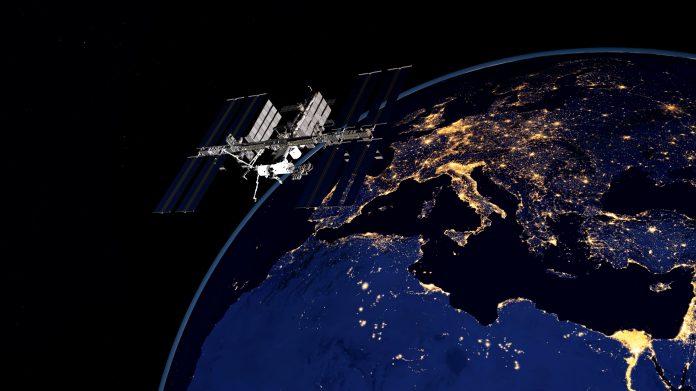Students are navigating satellites’ brightness and speed to declutter space traffic and assist astronomers by preventing light trails on their telescope-mounted cameras
As more companies launch networks of satellites into low-Earth orbit, a clear view of the night sky is becoming rarer. Astronomers are looking for new ways to adapt to satellites’ brightness and speeds.
Satellite development is now across the sky, reflecting light from the sun back down to Earth, especially during the first few hours after sunset and the first few hours before sunrise, which can distort the view of the stars and be a hindrance to astronomers.
To tackle this, University of Arizona students and faculty made a study to track and characterise the brightness of satellites, using a ground-based sensor they developed to measure satellites’ brightness, speed, and paths through the sky.
This work will be beneficial to astronomers, when notified of incoming bright satellites, can close the shutters of their telescope-mounted cameras to prevent light trails from tainting their long-exposure astronomical images.
Helpful for astronomers and their astronomical images
The team developed a satellite tracking device to measure the brightness and position of SpaceX Starlink satellites and compared those observations to government satellite tracking data from the Space Track Catalog database.
The problem with satellites is that they require power harvested from solar panels, which can reflect sunlight at ground-based telescopes and, in turn, impact astronomical observations from telescopes around the world.
Making 353 measurements of 61 satellites over two years, they found that the position of Starlink satellites as recorded in the government’s Space Track Catalog only differed by an average of 0.3 arc seconds from the UArizona calculations.
An arc second on the sky is about the size of a dime held 2.5 miles away, which makes a tiny difference due to natural lag times in the government data. As this data is based on estimated orbits calculated days earlier, rather than on real-time observations, positioning errors can build up and hinder astronomer’s work.
“This suggests that there is hope that astronomers can use these data to close the shutter of their telescopes in time amid the growing chaos in the skies above.”
Grace Halferty, a senior graduating this summer in aerospace and mechanical engineering, and is the lead author of the study, said: “Until now, most photometric – or brightness – observations that were available were done by naked eye.
“This is one of the first comprehensive photometric studies out there to go through peer review. The satellites are challenging to track with traditional astronomical telescopes, because they are so bright and fast-moving, so we built what’s basically a small sensor with a camera lens ourselves because there was nothing off the shelf available.”
The research team was led by professor of planetary sciences Vishnu Reddy, who added: “This suggests that there is hope that astronomers can use these data to close the shutter of their telescopes in time amid the growing chaos in the skies above.”
SpaceX started launching Starlink satellites in 2019, and it has kept growing
Starlink is a large network of satellites, also known as a mega constellation, operated by SpaceX with the goal of providing global internet coverage. Starlink has launched over 2,700 satellites, with an intended goal of achieving up to 42,000 satellites in the future.
According to researchers, around 30% of all telescope images will be impacted by at least one satellite trail once the Starlink constellation is complete.
These satellites are even more reflective after they launch, and can be often as bright as Saturn or Jupiter, which are two of the brightest objects in the night sky. As they maneuver into higher orbits, they become slightly fainter, but the researchers still needed to understand how to dim this light during the orbit stage.

SpaceX has come up with a few different methods to darken its Starlink satellites, including VisorSat satellites which rely on a shade to block additional sunlight, making them 1.6 times fainter.
DarkSat satellites, on the other hand, rely on an anti-reflective coating that makes them 4.8 times fainter. However this was not without flaws, as DarkSats got too hot, SpaceX had to change that specific method.
Tanner Campbell, a graduate research assistant in the Department of Aerospace and Mechanical Engineering, said: “As other constellations are added, the problem will only get worse for ground-based astronomical surveys.”
New strategies to reflect sunlight away, and using darker materials
In July, SpaceX announced new strategies. One involves mirrors that reflect sunlight away from Earth and another involves using darker building materials, which the researchers will aim to present how effective these methods are at reducing sunlight reflection back to Earth.
Knowing exactly where satellites are is helpful to astronomers, but the act of shutting the cameras adds overhead costs for telescope operations. Additionally, surveys become less efficient when astronomers have to close the shutter or throw away contaminated images.
According to researchers, a survey that would take five years to complete could take 10% to 20% more time if survey efficiency is down. Costs would be affected as more satellites are launched.
The team will continue to study the brightness of the latest generation of Starlink satellites in four different coloured filters with Tucson-based small business Starizona, which are the same ones used in astronomical surveys of the sky to tease out different information from stars, planets and more.











